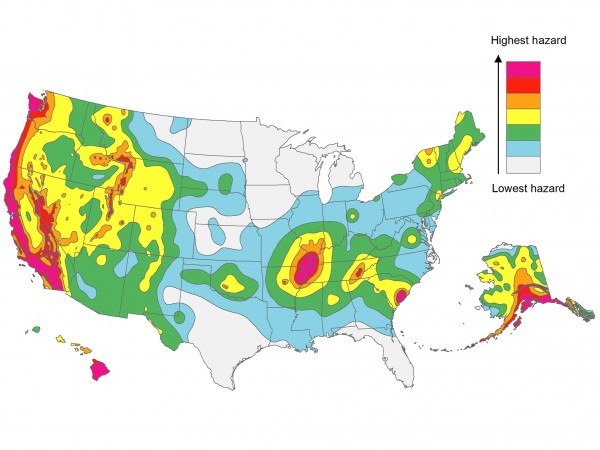
The best-known earthquake zones - California, the Pacific Northwest, and the Intermountain West - still dominate the hazard picture. Farther east, hot spots around the New Madrid Seismic Zone in the center of the country and Charleston, South Carolina, reflect the memory of powerful historical quakes (in 1811 to 1812 and 1886, respectively). But, in fact, all 50 states have the potential for earthquakes, and damaging ground shaking could happen in 42 of the 50 states within 50 years, the new report suggests. Of those, 16 states, all of which have had earthquakes of at least magnitude 6 in historical times, are considered highly likely to experience damaging ground shaking.
To assess the risk of where and how often future earthquakes will occur, and how hard the ground will shake, scientists are constantly seeking new data from these regions and using them to develop new ways of modeling ground motion, says Mark Petersen, a seismologist at USGS in Golden, Colorado, and the lead author of the new report. Among the latest temblors incorporated into the assessment is the 2011 5.8-magnitude Virginia earthquake, which "helped us understand better ground shaking in the central and eastern United States," Petersen says. New data also came from the U.S. Nuclear Regulatory Commission (NRC), which in 2010 published its own risk assessment for earthquake damage to its power plants in the central and eastern United States. These all suggest the region has the potential to experience an even more powerful quake.
Modern earthquake risk in the New Madrid Seismic Zone - which experienced three powerful quakes 200 years ago but nothing on that order since - remains a bone of contention. Some seismologists - most notably Seth Stein of Northwestern University in Evanston, Illinois - contend that ongoing quakes in the region are aftershocks of the three big ones, not signs of new seismic activity, and that USGS is overestimating the risk there. However, others dispute this; a paper published in Science earlier this year suggested that the region is still very much alive. All of this makes for a headache for those trying to sort out appropriate building codes and engineering designs; to try to bring some harmony to the dispute, the latest hazard assessment incorporated a model that followed some of Stein's ideas, including using GPS to detect tectonic strain in the region, as well as the data from NRC. The result - though unlikely to settle the debate anytime soon - was "a broader range of [earthquake] magnitudes and recurrence rates for New Madrid than we had before," Petersen says.
In California, the 2014 assessment has been significantly adjusted, thanks in large part to the brand-new Uniform California Earthquake Rupture Forecast model, which allows scientists to come up with rupture scenarios that are "plausible" for the state's complex network of faults, Petersen says. That changed the hazards on a highly local basis, but also extended the potential for damage farther across the state.
Some of the biggest change in earthquake risk is in the Cascadia Subduction Zone, which extends from British Columbia down to northern California. The powerful shaking from several recent subduction zone earthquakes around the world - notably the 9.0-magnitude Tohoku earthquake in 2011 and the 8.2-magnitude quake off the coast of Chile in 2014 - and geologic evidence from deep-sea cores of powerful quakes in the past now suggest that southern Cascadia could experience an earthquake as powerful as magnitude 9.3.
One thing the new report doesn't include is hazard due to induced seismicity - earthquakes related to human activities, such as reintroducing wastewater into injection wells. That's a layer that USGS plans to include, Petersen says - but right now, it's not quite clear how to do it. "We basically want to treat them separately from the other earthquakes," he adds, because mapping the hazards from human activities requires "a different logic tree." USGS is now planning regional workshops to discuss how to incorporate the hazard into its next generation of maps.
There is indeed a growing sense of urgency to the question. "I think it's incredibly striking what's happened the last few years with the increase of seismicity in the eastern and central U.S.," says Emily Brodsky, a seismologist at the University of California, Santa Cruz. "It really changes the story and the hazard implications. We're dealing with places that historically have not thought a lot about earthquakes."
It's still an open question whether human-induced earthquakes will actually rupture in similar ways to natural quakes, Brodsky adds. "That is the question we really need to assess - whether or not anything is different physically, or whether they'll interact, have connected ruptures." And that's one of the big general innovations in the new report, she adds - incorporating the way ruptures will actually connect and interact with one another, potentially creating a much larger and more catastrophic event than would occur from an individual rupture. Modeling rupture connectivity doesn't just apply to California's complicated network of faults - it can also have implications for the hazard assessed from induced quakes, she says.
Carolyn Gramling is a staff writer for Science and is the editor of the In Brief section.



Reader Comments
to our Newsletter